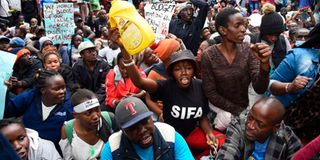We need new ideas on social protection

Kenyans protest outside the Office of the President in Nairobi on July 7, 2022, over the high cost of living.
What you need to know:
- The Azimio manifesto takes a very positive view of cash transfers, describing them “not as handouts, but as an investment.
- The Kenya Kwanza manifesto appears positive about social protection but is short on specific plans to expand current programmes or launch new ones.
The rising cost of living in Kenya has seen ordinary people repeatedly taking to the streets this year.
Sometimes this has been in intentional protests, like the Saba Saba march calling for a 'Njaa Revolution' to lower food prices.
Social protection programmes, a.k.a. social safety nets, can help to cushion vulnerable citizens during times of economic crisis.
But Raila Odinga’s Azimio la Umoja alliance and William Ruto’s Kenya Kwanza alliance have different ideas about how to use social protection to support Wanjiku.
Since 2003, Kenya has provided cash transfers to poor households through the National Safety Net Programme (NSNP), also known as Inua Jamii.
The current programmes include grants for orphans and vulnerable children; people with disabilities; people affected by drought in arid and semi-arid lands; and all citizens over age 70.
In 2019, the safety net covered over 1.3 million households. That’s roughly 5 million people or 10 per cent of the population.
However, this falls short of the estimated 33.4 per cent of the population (roughly 17 million people) still living under the $1.90 poverty line in 2022.
Build on programmes
How will the candidates build on this existing social protection programming?
The Azimio la Umoja manifesto takes a very positive view of cash transfers, describing them “not as handouts, but as an investment …(that will) trigger economic activity”.
An Azimio government would triple the current cash transfer value, from Sh2,000 to Sh6,000 monthly; raise total NSNP enrollment from 1.3 million to at least 2 million households; offer cash transfers to single mothers; and create a new public works programme for unemployed youth.
Taken together, these promises would expand the number of social protection beneficiaries by more than 50 per cent.
Meanwhile, the Kenya Kwanza manifesto appears positive about social protection but is short on specific plans to expand current programmes or launch new ones.
The manifesto calls for the government to establish “a universal social security system, encompassing pension, occupational hazard and unemployment insurance”.
However, it’s not clear how this would relate to the universal social pension for people over 70, which is already offered through the NSNP.
But here’s an interesting idea: “establish a social welfare system for Kenyans living in the diaspora, by exploring and implementing the portability of social protection”.
Many Kenyans abroad face exploitative working conditions and lack access to national social protection systems in their country of residence, so this seems like a concept worth exploring.
Ultimately, there are good ideas about offering social protection to new populations in both Raila and Ruto’s manifestos. Azimio’s commitment to expanding coverage and Kenya Kwanza’s focus on workers are all welcome.
Rachel Strohm, Nairobi




